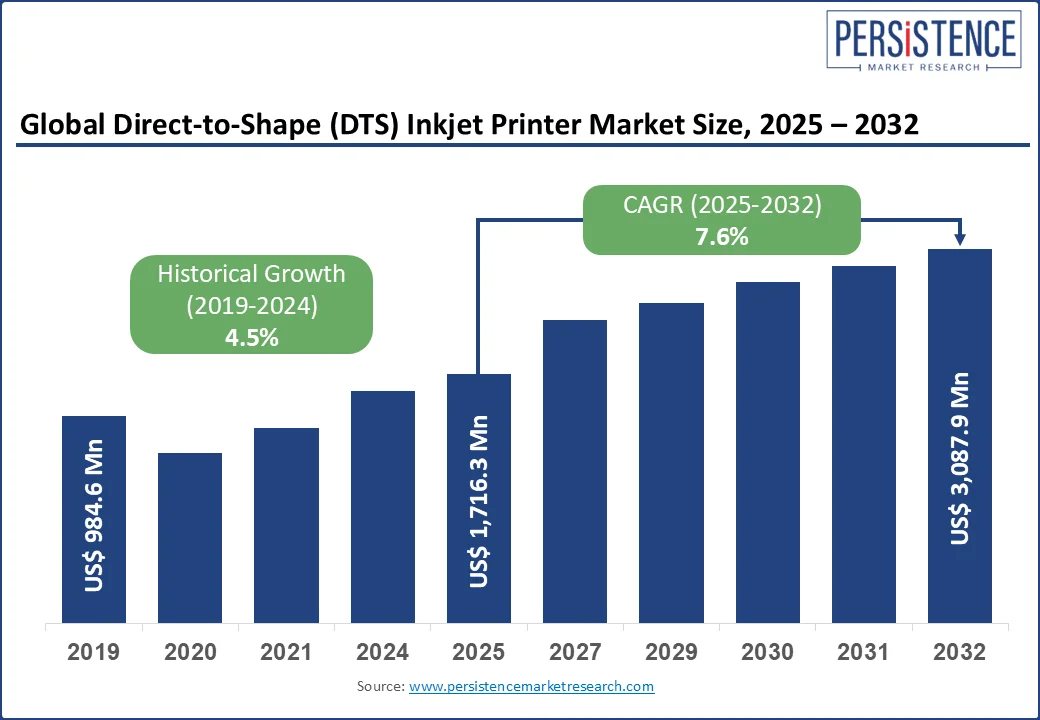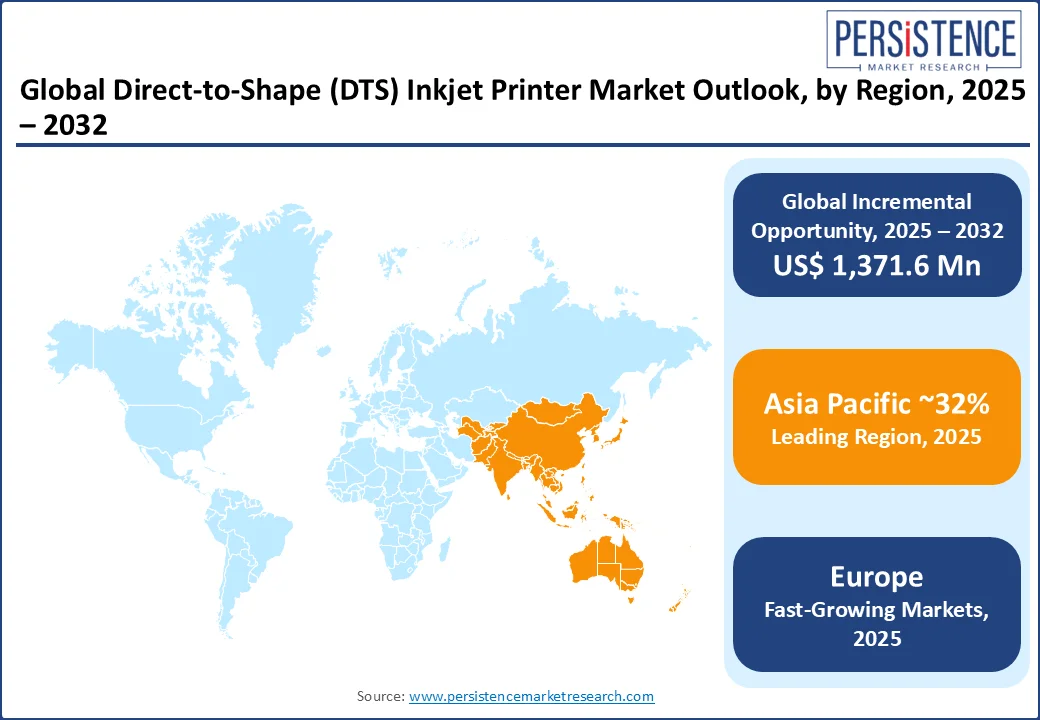ID: PMRREP35552| 189 Pages | 6 Aug 2025 | Format: PDF, Excel, PPT* | Consumer Goods

The global Direct-to-Shape (DTS) Inkjet Printer market size is projected to rise from US$1,716.3 Mn in 2025 to US$3,087.9 Mn by 2032. It is anticipated to witness a CAGR of 7.6% during the forecast period from 2025 to 2032. The direct-to-shape inkjet printer is witnessing robust growth as brands and packaging converters increasingly seek digital printing solutions that enable customization, flexibility, and shorter time-to-market. DTS printers eliminate the need for intermediate substrates, allowing ink to be applied directly onto 3D objects such as bottles, jars, cans, and tubes. This capability aligns with the growing demand for personalized and limited-edition packaging in industries.

Key Industry Highlights:
|
Global Market Attribute |
Key Insights |
|
Direct-to-Shape (DTS) Inkjet Printer Market Size (2025E) |
US$ 1,716.3 Mn |
|
Market Value Forecast (2032F) |
US$ 3,087.9 Mn |
|
Projected Growth (CAGR 2025 to 2032) |
7.6% |
|
Historical Market Growth (CAGR 2019 to 2024) |
4.5% |
DTS technology eliminates the need for separate packaging layers by enabling direct decoration of three-dimensional objects such as bottles, tubes, cans, and containers. This reduces material usage and waste while allowing brand owners to explore edge-to-edge designs that wrap around intricate contours, enhancing visual appeal and consumer engagement. With growing demand for personalized products in sectors such as cosmetics, beverages, and consumer goods, DTS inkjet printers enable short-run, high-mix production through variable data printing (VDP), supporting individualized designs, text, and QR codes without changing plates or screens.
These printers support a wide range of rigid packaging substrates, using UV-curable inks and advanced adhesion promoters that ensure vibrant color and durable prints. For instance, in June 2025, Seiko Epson Corporation will debut its Direct to Shape Printing System at Automatica 2025 in Germany, marking its first international showcase. The system combines S800 PrecisionCore printheads with a 6-axis robot for precise, high-resolution (600×600 dpi) printing on complex 3D objects. Designed for applications from helmets to automotive parts, it enables sustainable, cost-effective customization without traditional plates.
The printers involve complex ink delivery systems, precision nozzles, and advanced motion control mechanisms that must operate in sync. Maintaining consistent jetting quality, especially on uneven or non-standardized surfaces, requires frequent calibration and cleaning. For instance, operators must routinely clean printheads to prevent clogging, a common issue when UV-curable or solvent-based inks are exposed to air. This leads to increased machine downtime and higher operational costs, posing challenges for small and mid-size enterprises operating with limited resources.
Ink adhesion and durability present additional constraints, particularly when printing on non-porous substrates such as glass, metal, or hard plastics. To ensure bonding and prevent flaking or fading, surface pretreatments such as plasma cleaning, flame treatment, or chemical primers are often required. These extra steps complicate workflows, reduce throughput, and inflate production costs. A 2024 FDA Enforcement Report analysis by Loftware found that label errors often related to print quality accounted for 45.5% of 422 food recall events.
Microelectromechanical systems (MEMS) printheads with nozzles as small as 1 picoliter now enable ultra-fine droplet delivery, achieving resolutions up to 4800 x 2400 dpi, critical for high-quality graphic arts and packaging. Piezoelectric printheads enhance this precision through variable droplet control using electronic pulses, enabling high-speed, high-resolution printing for demanding, high-volume applications. Beverage companies like Coca-Cola have adopted DTS printing for label-free, recyclable PET bottles, aligning with Europe’s sustainability-driven regulatory environment.
Advanced printhead technologies such as Epson’s PrecisionCore and Fujifilm’s Dimatix offer micron-level droplet control, allowing high-definition grayscale and multi-drop printing on 3D surfaces such as cosmetic packaging. Digital DTS systems support cost-effective short runs and one-off customizations, benefiting personalization-focused brands with agile production and faster market entry. For example, Ricoh’s industrial inkjet heads integrate internal heating and ink recirculation, reducing clogging and maintenance, ensuring continuous, high-quality output in production lines.
The rise of smart packaging and interactive labeling is transforming the packaging landscape. Technologies such as QR codes, NFC tags, and embedded sensors are increasingly integrated into consumer goods to enable real-time data sharing, traceability, and improved consumer engagement. Brands are embracing 360° and full-surface decoration, especially in cosmetics, beverages, and personal care, to enhance shelf appeal and support premium branding, unconstrained by traditional label shapes or sizes.
As regulatory pressure around packaging waste grows and consumers demand sustainable solutions, label-free packaging enabled by DTS printing has gained traction. By printing directly onto recyclable containers, it eliminates the need for adhesive labels and shrink sleeves, aligning with circular economy goals and frameworks such as the EU Packaging Waste Directive (2024 revision) and India’s Plastic Waste Management Rules. DTS supports just-in-time production and customization, reducing overproduction, minimizing waste, and aligning with sustainability and EPR mandates.
Based on material type, the market segmentation includes plastic, glass, metal, ceramic, and others. Among these, plastics are projected to generate a market share of over 43% in 2025 due to their lightweight properties, cost-effectiveness, and compatibility. Their smooth surface allows for high-resolution printing, while the shift toward recyclable mono-materials supports growing demand for sustainable packaging. Advancements in ink adhesion and curing technologies further enhance their suitability for DTS applications.
Glass material is projected to grow significantly due to the increasing demand for sustainable and recyclable packaging. The ability of DTS printing to deliver full-color, high-resolution graphics directly on curved and transparent glass surfaces boosts its appeal. Glass also offers premium aesthetics and durability, making it ideal for personalized branding.
In terms of ink type, the market is segregated into UV curable inks, solvent-based inks, water-based inks, electron beam curing inks & others. Out of these, UV curable inks are expected to account for more than 57% share in 2025, driven by their fast-drying capability, strong adhesion on diverse substrates, and superior durability. Their compatibility with high-speed DTS printing enables sharp, vibrant prints without the need for pre-treatment. UV curable inks align with sustainability goals due to low VOC emissions and reduced waste.
Electron beam curing ink is expected to grow at a significant rate due to its solvent-free formulation, which aligns with growing environmental regulations. It offers superior adhesion and durability on non-porous surfaces, making it ideal for high-performance packaging. The rapid curing process at low temperatures enhances production speed and energy efficiency. As demand rises for food-safe, low-VOC, and heat-sensitive substrate printing, electron beam curing becomes increasingly viable.

In North America, regulatory efforts to reduce single-use plastic waste and improve recyclability are shaping packaging strategies. The U.S. EPA’s National Strategy to Prevent Plastic Pollution promotes reduced virgin plastic use, increased post-consumer recycled (PCR) content, and better recyclability design through 2025. Consumers are increasingly demanding sustainable and visually appealing packaging, minimalist or bold designs, transparency, smart codes, and high-resolution graphics. A 2024 GS1 survey reported that 79 % of U.S. shoppers prefer QR coded packaging providing sustainability or traceability info.
The rapid rise of e-commerce and brand personalization is pushing demand for flexible, visually impactful packaging. DTS printers support short-run and region-specific campaigns, such as beverage companies in the U.S. customizing cans with local sports branding or seasonal designs. Strict U.S. and Canadian regulations for traceability, such as the FDA’s FSMA, make DTS valuable for directly printing QR codes, lot numbers, and expiry dates on containers, reducing label mismatches and ensuring regulatory compliance without added labeling steps.
Asia Pacific is predicted to generate a share of over 32% in 2025. China’s government reported a +5.0% GDP growth for 2024, with manufacturing value-added up 6.1% and high-tech manufacturing growing 8.9%, including 7.1% growth in computer & office equipment. This reflects the country’s push for industrial modernization and equipment upgrades, driving demand for high-precision inkjet systems in packaging and production lines. In Japan, the aging population and shrinking labor force are driving automation, with printers being adopted for their ability to deliver intricate, high-resolution graphics on packaging, especially for premium products like skincare and electronics.
South Korea’s Hallyu or Korean Wave continues to boost demand for personalized packaging in cosmetics and entertainment merchandise. The use of advanced printing enables vibrant, customized designs that resonate with consumers, while eco-friendly inks and substrates support sustainability goals. In India, urbanization and the rapid growth of beverage, dairy, and processed food sectors are pushing brands toward automation and high-impact packaging. Under the Make in India initiative and recent environmental guidelines to curb single-use plastics, DTS printing is emerging as a key enabler of eco-friendly, efficient packaging solutions.
Across Europe, new regulatory pressures such as the EU Packaging and Packaging Waste Regulation (PPWR, Regulation (EU) 2025/40) are prompting packaging producers to shift toward recyclable, reusable, and eco-designed formats. In Germany, DTS printers are blended with high-speed. With the VerpackG law and a mature recycling system processing over 5.5 million tonnes of household packaging waste in 2023, Germany witnessed a jump from 42.1% in 2018 to 68.9% in 2023 for mechanically recycled plastic packaging, thus driving demand for DTS systems that use eco-inks and reduce label waste.
In the UK, an Extended Producer Responsibility (EPR) scheme, effective from October 2025 reflects on the charges based on the packaging weight and recyclability, pushing the retail sector to adopt cost-saving, sustainable printing solutions. France’s luxury and sustainability-conscious market is turning to DTS printers for high-resolution, direct-on-container prints on curved glass perfume bottles and cosmetic jars, reducing extra labeling. There is a growing need in Italy’s design-driven sectors, such as wine, olive oil, and high-end cosmetics, for DTS printing solutions that enable direct, full-color printing on materials. This allows producers to develop recyclable mono-material packaging that meets EU waste reduction targets while delivering the premium aesthetic and branding essential to compete in luxury markets.

The global direct-to-shape (DTS) inkjet printer market is consolidated. Manufacturers are focusing on differentiation through advanced printhead technology, sustainable ink formulations, and compatibility with diverse substrates such as glass and metal. Many players adopt customization and modular design to meet brand-specific needs, especially in the cosmetics, food, and beverage sectors. R&D investments and automation integration reduce downtime and improves throughput, enhancing competitiveness.
The global Direct-to-Shape (DTS) Inkjet Printer Market is projected to be valued at US$1,716.3 Mn in 2025.
The need for cost-effective, high-quality, and sustainable packaging solutions that enable on-demand, full-color printing directly on 3D objects without labels is the key market driver.
The Direct-to-Shape (DTS) Inkjet Printer market is poised to witness a CAGR of 7.6% from 2025 to 2032.
Rising demand for customized and smart packaging, driven by e-commerce and QR/NFC-enabled labels, is creating significant opportunities for product personalization and brand differentiation.
Xerox Corporation, Xaar plc, Velox Ltd., Roland DGA Corporation, and Seiko Epson Corporation are among the leading key players.
|
Report Attribute |
Details |
|
Historical Data/Actuals |
2019 - 2024 |
|
Forecast Period |
2025 - 2032 |
|
Units |
Value: US$ Bn/Mn, Volume: As Applicable |
|
Geographical Coverage |
|
|
Segmental Coverage |
|
|
Competitive Analysis |
|
|
Report Highlights |
|
|
Customization and Pricing |
Available upon request |
By Material Type
By Printer Technology
By Ink Type
By End-Use Industry
By Region
Delivery Timelines
For more information on this report and its delivery timelines please get in touch with our sales team.
About Author